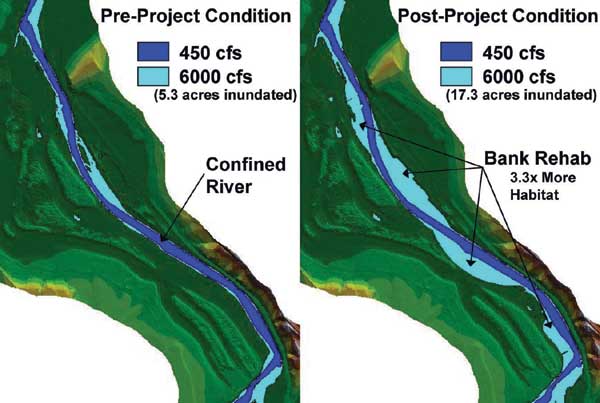Trinity River Bank Restoration to begin at Hocker Flat
By: Joe Riess, Civil Engineer,
Trinity River Restoration Program
The banks of the Trinity River downstream of Junction City look different these days. If you drive on Highway 299 you will notice patches that have been cleared of trees and blackberries along about a mile of the Trinity Riverís edge. The Trinity County Resource Conservation District recently completed clearing this riverbank vegetation to set the stage for the Trinity River Restoration Programís first channel rehabilitation project. Major construction of the project ó the actual earthmoving with heavy equipment ó will start later this summer, but the trees and blackberry bushes were cut this winter before birds began selecting nesting sites, as required under agreements with the California Department of Fish and Game. This summer a contract will be awarded to a local contractor to feather back the riverís banks to form a gradual slope (at a 10% grade), excavate materials from the floodplain, and move excavated materials outside of the Federal Emergency Management Agencyís (FEMA) 100-year inundation zone. The project is designed to flood when flows in the Trinity River are above 6,000 cubic feet per second, creating much needed slow water rearing habitat for young salmon. The channel manipulation will allow the floodplain to be scoured by high water more frequently, to provide seasonal aquatic habitat for fish and other aquatic species, and to prevent riparian vegetation from encroaching along the riverís edge. A wide range of plant species will be planted next winter to help keep the less desirable plants such as star thistle from taking over the rehabilitated floodplain.
The Hocker Flat bank rehabilitation project is just one of 47 sites along 42 miles of the Trinity River between Lewiston Dam and the North Fork Trinity River near Helena. Preliminary designs are underway for four additional sites on the River near Canyon Creek, with construction anticipated to begin in spring of 2006. This first project at Hocker Flat is intended to work with these future projects to create a broader, more diverse river that will function, on a smaller scale, like the historical Trinity River. Overall, access to the river and views of the river from the surrounding area will be enhanced, and fish and wildlife habitat associated with the properties will increase. The negative visual impacts associated with this summerís construction will fade and improve over time as revegetation takes hold.
Initial planning efforts have already begun for 11 sites near Lewiston and Indian Creek. For additional information you can call Joe Riess, Trinity River Restoration Program, at 623-1811.
|





